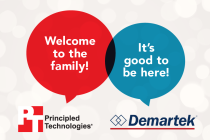Demartek Comments on Storage Networking World Spring 2009
10 April 2009
It was another successful and busy week at Storage Networking World (SNW) Spring 2009 in Orlando. Although the number of vendors, by my count, was 48% of what it was in Spring 2008, it was apparent that the vendors who did participate sent fewer people. However, the SNW officials said that the end-user attendance was 92% of what it was in Spring 2008. Obviously travel budgets have been cut, and this was reflected in the end-user attendance, which had shifted to many local IT professionals from the central Florida region.
I was delighted to give my Storage Best Practices for Microsoft Applications session on Monday morning, and it was a full room with approximately 125 people. One person tweeted that it was the best session on Monday. Thanks!
The obvious buzz at this SNW was Solid State Storage (SSS) or Solid State Disk (SSD), whichever you like. There was a Solid State track, of which my presentation was the first of ten sessions, and SSDs were discussed in other sessions. There is lots of noise and with that noise often comes confusion. I have been testing various SSDs, including DRAM and NAND-flash types of solid state in my test lab, and will continue to do so throughout this calendar year. I hope to clarify some of the confusion around SSDs as I publish results throughout the year.
A few years ago, I said to some of my colleagues that I was looking for the enterprise version of the USB flash drive. In my opinion, that time has arrived and things are heating up. Although solid state storage has been with us for many years, the renewed attention it is commanding these days is causing many of us to begin to re-think storage. [Note: see my SSDs in the Enterprise article.] We don’t need to restrict our thinking to the traditional ways of “doing storage”. A number of new form factors and interconnects for enterprise and consumer solid state storage are emerging. One vendor I spoke to at SNW this week said that although they currently have SSDs in traditional disk drive form factors, their long-term plan is to move away from those form factors. Personally, I’d like to see storage move closer to the CPU and become an extension of system memory. Some of the users at SNW were also talking about this. I believe that in three years time, some form of solid state storage, possibly NAND-flash storage, will become the standard for tier-1 storage.
As one of the Wikibon analysts, I spent quite a bit of time in the Wikibon Tweet Suite with vendors discussing their current and new technologies and solutions. The Wikibon analysts were all using Twitter during these meetings and tweeting about these companies and their products real-time. Some of them even tweeted about us while we were tweeting about them. Check our main page and our blogs to get the latest information.
We met with several companies during the week in the Wikibon Tweet Suite. Here are just a few of my notes from some of these meetings. Symantec told us that energy consumption accounts for the 2nd largest I.T. operating expense after salaries. They are working to provide management tools that help monitor and measure this with their Altiris product family. For example, Altiris can turn direct groups of PCs to turn off their monitors, go to sleep and hibernate on command. Storwize told us about their lossless data reduction technology, also known as compression, that helps to optimize the data footprint. They told us how their technology can compress files in flight and at rest, and can compress files that are open. QLogic discussed their second generation FCoE Converged Network Adapters (CNAs) and about their interoperability program and their OEM design wins. Fusion-IO explained their DVD streaming video demonstration they had running on the show floor and discussed their NAND-flash technology in general. HP told us about their management tools and the StorageWorks I/O Accelerator that uses Fusion-IO SSD technology. 3PAR explained their new “F” class mid-range storage and about their “F” marketing campaign. STORserver explained their backup and recovery appliance that is bundled with IBM TSM.
Other big topics we discussed were de-duplication and its integration with backup technologies, 6-Gbps SAS, FCoE, and more. [Note: read about some of our FCoE work.] Of course, no conference these days would be complete without some discussion of server virtualization and its impact on storage. Expect to hear more from me on this topic.
I’m always interested in testing various configurations of real-world applications. Contact me via email with your suggestions. You can also follow me on Twitter.
This article is also posted on the Wikibon blog page.
29 July 2009
I've also been asked to present a
Unified Storage Networking and FCoE session at SNW in Phoenix in October 2009.

 We are pleased to announce that Principled Technologies has acquired Demartek.
We are pleased to announce that Principled Technologies has acquired Demartek.